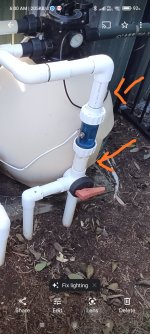Hi all,
I currently have a copper/ionizer system which is working great, but still need to add small amounts of chlorine and acid as normal. I got to thinking after having a pump house built next to the pool whether I could run 6mm tube off a hand pump and then dug deeper and found the stenner world via AliExpress of all places. I just have a couple of questions if anyone can please clarify?
I plan to run a double head pump. One for acid and one for chlorine. Acid at 20ml per minute and chlorine at 40ml per minute for 5 minutes per day giving me 700mls of acid and 1400mls of chlorine each week in a constant but very low, slow dose. Any issues for this low rate?

 a.aliexpress.com
a.aliexpress.com
I have the UCAK300 quill coming as it was said here the non return valve is not necessary and at such a low rate, I was worried about not reaching a cracking pressure to pass through the valve. What is to stop water from the pool return line entering the injection quill? "They tell me that the check valve is not a necessity." https://www.troublefreepool.com/threads/stenner-liquid-chlorine-pump-how-to-choose-and-install.169591/#:~:text=They%20tell%20me%20that%20the%20check%20valve%20is%20not%20a%20necessity.
Is 1/4" NPT tap what I need to make the hole? And should it be on a downward angle (like 45 degrees) or just 90 degrees to the pipe?
Will it be ok to use a tee to run the acid and chlorine together before going into the injection point?
Thanks heaps. I'm excited to get it working. I'm in Australia and stenner stuff is pretty hard to come by without costing a small fortune.
I currently have a copper/ionizer system which is working great, but still need to add small amounts of chlorine and acid as normal. I got to thinking after having a pump house built next to the pool whether I could run 6mm tube off a hand pump and then dug deeper and found the stenner world via AliExpress of all places. I just have a couple of questions if anyone can please clarify?
I plan to run a double head pump. One for acid and one for chlorine. Acid at 20ml per minute and chlorine at 40ml per minute for 5 minutes per day giving me 700mls of acid and 1400mls of chlorine each week in a constant but very low, slow dose. Any issues for this low rate?

25.0US $ |Small Intelligent Peristaltic Pump Dosing Pump Flow Adjustable, Easy Use Grothen 8ml/min To 240 Ml/min G628-2 - Pumps - AliExpress
Smarter Shopping, Better Living! Aliexpress.com
I have the UCAK300 quill coming as it was said here the non return valve is not necessary and at such a low rate, I was worried about not reaching a cracking pressure to pass through the valve. What is to stop water from the pool return line entering the injection quill? "They tell me that the check valve is not a necessity." https://www.troublefreepool.com/threads/stenner-liquid-chlorine-pump-how-to-choose-and-install.169591/#:~:text=They%20tell%20me%20that%20the%20check%20valve%20is%20not%20a%20necessity.
Is 1/4" NPT tap what I need to make the hole? And should it be on a downward angle (like 45 degrees) or just 90 degrees to the pipe?
Will it be ok to use a tee to run the acid and chlorine together before going into the injection point?
Thanks heaps. I'm excited to get it working. I'm in Australia and stenner stuff is pretty hard to come by without costing a small fortune.


